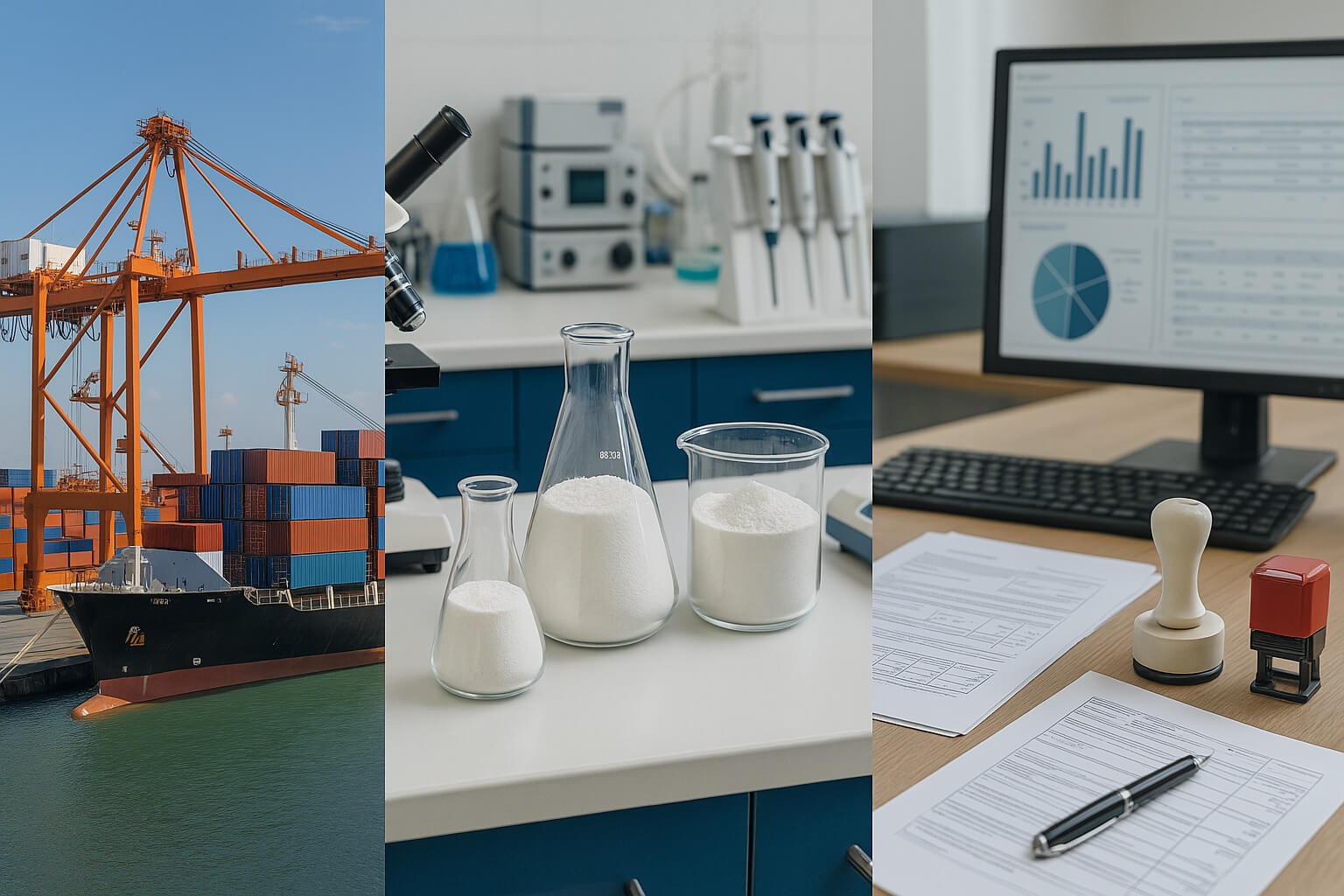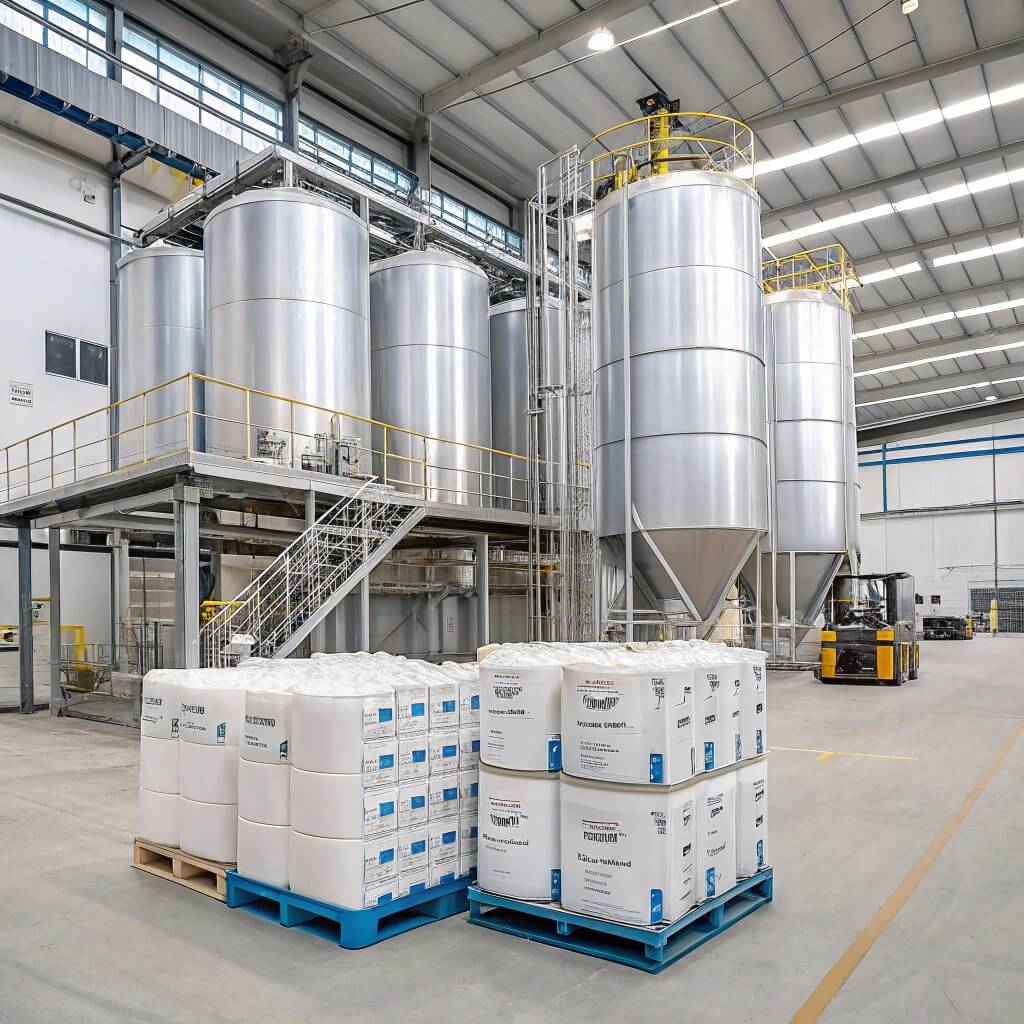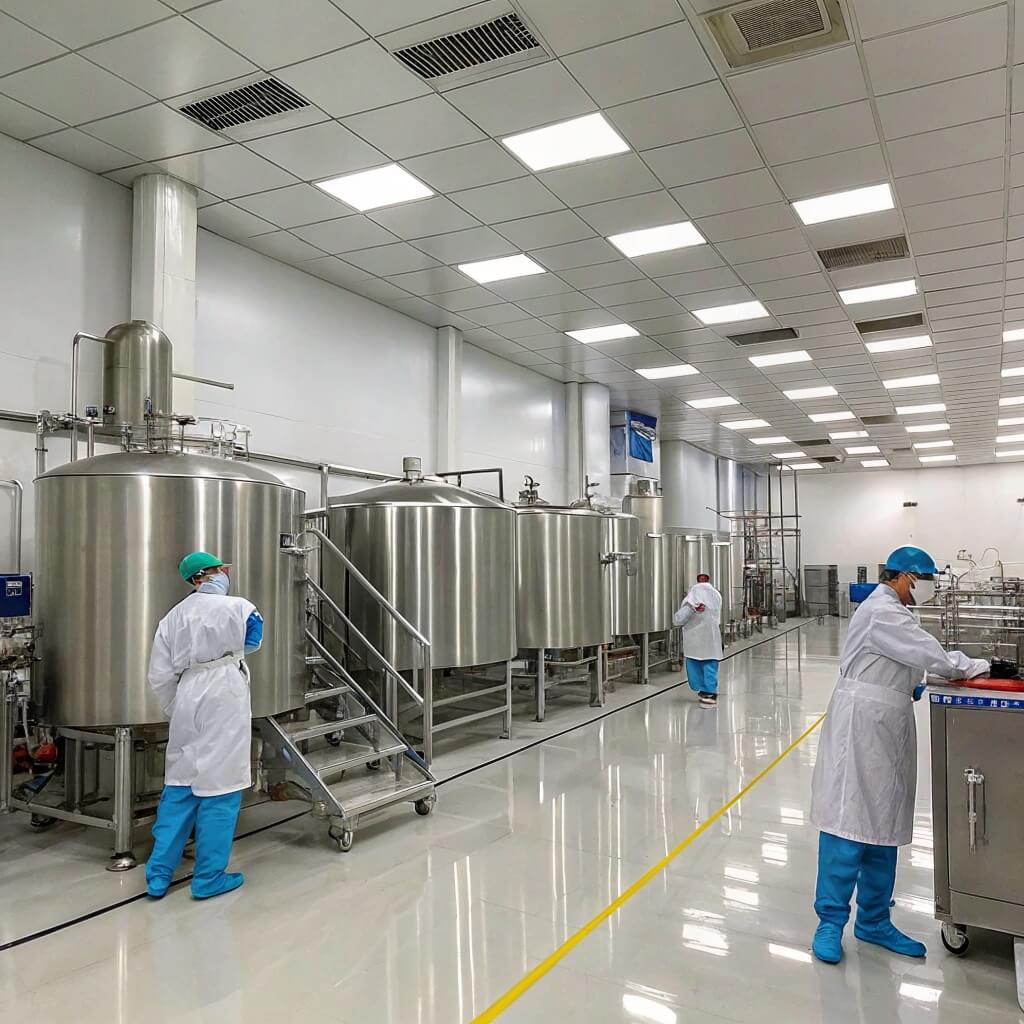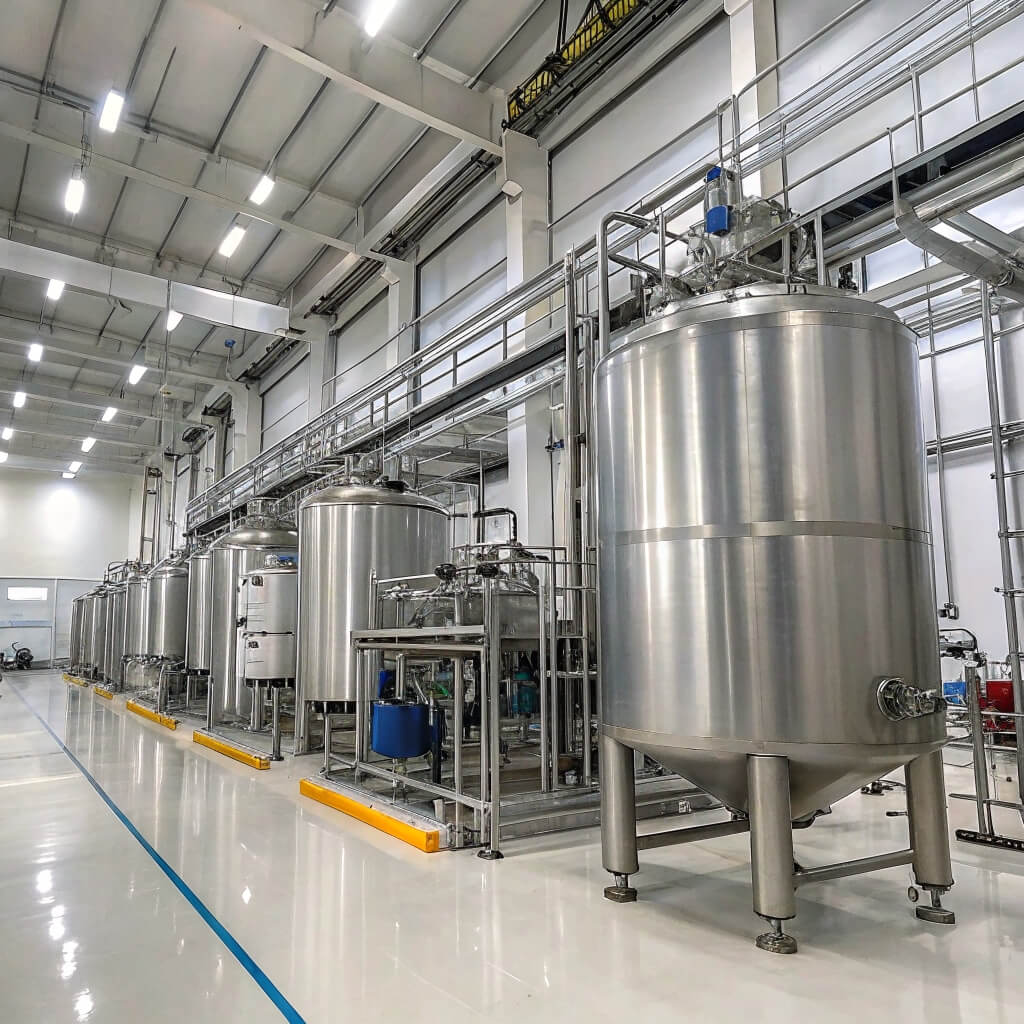Finding reliable chemical suppliers overseas can be daunting. With quality concerns and complex regulations, how can you import HPMC from China without costly mistakes?
Importing HPMC from China safely requires thorough supplier verification, product testing, proper documentation, customs compliance, and strategic payment terms. Key steps include background checks on manufacturers, obtaining proper certifications, conducting third-party inspections, and understanding chemical import regulations.

A comprehensive visual representation of the HPMC import process from China, showing shipping containers at port, laboratory quality testing procedures, and customs documentation requirements.
Navigating these requirements might seem complex, but with proper planning, importing HPMC from China can be both cost-effective and reliable.
What are the biggest risks when importing HPMC from China?
Chemical imports carry significant risks. What potential pitfalls should you watch for when sourcing HPMC from China?
Importing HPMC from China involves several key risks that procurement managers must address through proper due diligence and risk management strategies. Understanding these challenges is the first step toward implementing effective countermeasures.
Product quality inconsistency represents the most significant risk when importing HPMC from China. Variations in viscosity, substitution degree, particle size, and purity can dramatically affect performance in end applications. The American Chemical Society emphasizes that chemical quality variations can compromise product integrity and safety. These inconsistencies often stem from differences in manufacturing processes or raw material quality.
Regulatory compliance presents another major challenge. HPMC imports must meet destination country regulations for chemical substances, including registration requirements, safety data documentation, and application-specific approvals. For pharmaceutical or food-grade HPMC, these requirements become even more stringent. Non-compliance can result in shipment rejection, regulatory penalties, or even legal liability.
Supply chain disruptions pose ongoing risks for HPMC imports from China. Production delays, shipping congestion, customs holdups, or unexpected regulatory changes can all impact delivery timelines. These disruptions can cascade through production schedules, potentially causing costly manufacturing downtime.
Financial risks include payment fraud, quality disputes, and currency fluctuations. The traditional payment methods for international trade carry inherent risks if not properly structured. Quality disputes can lead to complex international arbitration if clear quality standards and testing protocols aren't established in advance.
| Risk Category | Specific Concerns | Mitigation Strategies |
|---|---|---|
| Qualität | Viscosity variations, impurity levels | Third-party testing, detailed specifications |
| Regulatory | Chemical registration, compliance | Pre-import verification, regulatory consultants |
| Lieferkette | Production delays, shipping disruptions | Buffer inventory, multiple supplier relationships |
| Financial | Payment fraud, quality disputes | Secure payment terms, quality verification |
How to identify a reliable HPMC supplier in China?
Supplier selection determines import success. What verification steps separate legitimate manufacturers from risky vendors?
Identifying reliable HPMC suppliers in China requires a systematic approach that combines background verification, capability assessment, and relationship development. This multi-faceted evaluation helps procurement managers distinguish between legitimate manufacturers and high-risk vendors.
Comprehensive background verification forms the foundation of supplier qualification. This process should include business license verification, manufacturing permit validation, and export license confirmation. The China Chamber of Commerce for Import and Export of Medicines and Health Products provides resources for verifying legitimate chemical exporters. Additionally, checking supplier history through credit reports and industry references helps establish operational longevity and business stability.
Manufacturing capability assessment provides critical insights into production capacity, technical expertise, and quality control systems. For HPMC suppliers, this assessment should focus on production equipment, laboratory facilities, and quality management systems. Request detailed information about production capacity, batch sizes, and manufacturing processes. Suppliers should readily provide this information along with evidence of quality control procedures.
Certification verification offers objective evidence of supplier compliance with international standards. Legitimate HPMC manufacturers should possess ISO 9001 quality management certification at minimum, with additional certifications depending on the intended application. For pharmaceutical-grade HPMC, look for GMP certification and pharmacopeia compliance documentation. Food-grade HPMC suppliers should have FSSC 22000 or similar food safety certifications.
Sample evaluation provides tangible evidence of product quality and supplier capabilities. Request samples from multiple production batches to assess consistency, and have these samples tested by independent laboratories against your specifications. This testing should verify key parameters such as viscosity, substitution degree, particle size distribution, and application-specific performance characteristics.
| Verification Area | Key Indicators | Rote Flaggen |
|---|---|---|
| Business Credentials | Valid business license, export permit | Recently established entities, limited online presence |
| Manufacturing Capability | Dedicated production facilities, in-house laboratory | Contract manufacturing only, limited technical expertise |
| Zertifizierungen | ISO 9001, application-specific certifications | Expired certifications, certificates from non-accredited bodies |
| Product Quality | Consistent sample performance, comprehensive CoA | Inconsistent test results, limited testing parameters |
What steps ensure product quality and consistency?
Quality verification prevents costly problems. Which testing protocols and specifications ensure HPMC meets your requirements?
Ensuring HPMC quality and consistency requires a comprehensive approach that combines detailed specifications, rigorous testing protocols, and systematic supplier management. These measures help procurement managers prevent quality-related problems that could impact production processes or end-product performance.
Developing detailed product specifications provides the foundation for quality assurance. These specifications should define all critical parameters for your specific application, including viscosity range, substitution degree, particle size distribution, moisture content, and purity requirements. The United States Pharmacopeia provides standardized specifications for pharmaceutical-grade HPMC that can serve as a reference point. Your specifications should also include acceptable testing methods and sampling procedures.
Pre-shipment inspection and testing represent critical quality verification steps. Third-party inspection companies with expertise in chemical products can conduct on-site inspections at the supplier's facility before shipment. These inspections should include production record review, packaging verification, and sample collection for laboratory testing. Samples should be tested against your specifications using standardized methods by independent laboratories.
Certificate of Analysis (CoA) verification ensures that supplier-provided documentation accurately reflects product characteristics. Each HPMC shipment should include a comprehensive CoA detailing test results for all specified parameters. This document should reference the testing methods used, include actual test values (not just "pass/fail" indications), and be traceable to the specific production batch.
Implementing a supplier quality agreement formalizes quality expectations and responsibilities. This legally binding document should outline quality specifications, testing requirements, notification procedures for process changes, and non-conformance handling protocols.
| Quality Assurance Step | Implementation Approach | Documentation Requirements |
|---|---|---|
| Specification Development | Define application-specific requirements | Detailed specification document with parameters and criteria |
| Pre-shipment Inspection | Third-party inspection at supplier facility | Inspection report with findings and collected sample details |
| Laboratory Testing | Independent testing of collected samples | Test reports with actual values for all parameters |
| CoA Verification | Cross-check supplier CoA against test results | Supplier CoA, independent test reports, verification documentation |
How to navigate shipping, permits, and customs for HPMC?
Logistics and compliance create import hurdles. What documentation and procedures ensure smooth HPMC customs clearance?
Navigating the logistics and regulatory aspects of HPMC imports requires careful planning and documentation to ensure smooth customs clearance and regulatory compliance. Understanding these requirements helps procurement managers avoid costly delays and compliance issues.
Proper Harmonized System (HS) code classification forms the foundation of HPMC import compliance. HPMC typically falls under HS code 3912.39, which covers "Cellulose and its chemical derivatives, not elsewhere specified, in primary forms." However, classification may vary based on specific modifications or intended applications. The World Customs Organization provides resources for understanding HS classification principles. Incorrect classification can result in improper duty assessment or regulatory non-compliance.
Import permit requirements vary by country and application. For pharmaceutical-grade HPMC, many countries require specific import permits or registrations through their drug regulatory authorities. Food-grade HPMC may require food additive registration or approval. Industrial-grade HPMC generally faces fewer restrictions but may still require chemical substance registration in some jurisdictions.
Documentation preparation ensures smooth customs clearance. Essential documents include the commercial invoice, packing list, bill of lading or airway bill, certificate of origin, and Certificate of Analysis. Depending on the destination country and HPMC grade, additional documentation may include import permits, safety data sheets, or specific declarations.
Shipping method selection impacts both cost and timeline. Ocean freight offers the most economical option for bulk HPMC shipments but requires longer lead times (typically 30-45 days from China to North America or Europe). Air freight provides faster delivery (5-7 days) but at significantly higher cost, making it suitable for urgent or smaller shipments.
| Import Aspect | Wichtige Überlegungen | Bewährte Methoden |
|---|---|---|
| HS Classification | Product specifications, chemical modifications | Obtain binding rulings for certainty |
| Import Permits | Destination country requirements, HPMC grade | Research requirements early, allow sufficient time |
| Documentation | Consistency across all documents, complete information | Create documentation checklist, review before shipment |
| Shipping Method | Order volume, timeline requirements, budget | Balance cost vs. speed, consider inventory planning |
What negotiation and payment strategies minimize risk?
Financial protection requires strategic planning. Which payment terms and contract provisions safeguard your HPMC imports?
Effective negotiation and payment strategies play a crucial role in minimizing financial risks when importing HPMC from China. These approaches help balance supplier relationships with appropriate financial protections throughout the transaction process.
Contract development with clear terms and conditions provides the legal foundation for HPMC imports. These contracts should specify product specifications, quality requirements, delivery terms, payment conditions, and dispute resolution mechanisms. The International Chamber of Commerce provides standardized Incoterms that define delivery responsibilities and risk transfer points. Contracts should also include provisions for quality verification procedures and remedies for non-conforming goods.
Payment term negotiation represents a critical risk management tool. While Chinese suppliers typically prefer advance payment or letters of credit, these terms place most financial risk on the buyer. More balanced approaches include:
- 30% deposit with 70% payment after pre-shipment inspection and testing
- Letters of credit with specific quality verification requirements
- Escrow services that release payment only after quality verification
- Payment terms tied to specific milestones (production completion, pre-shipment inspection)
For new supplier relationships, start with smaller orders and more secure payment terms until trust is established. As the relationship develops, payment terms can evolve to balance risk more equitably between both parties.
Price negotiation should focus on value rather than simply pursuing the lowest price. Extremely low HPMC prices often indicate quality compromises, use of inferior raw materials, or inadequate quality control processes. Instead, evaluate pricing in the context of total cost of ownership, including quality consistency, technical support, and reliability.
| Strategy Area | Risk Reduction Approach | Implementation Considerations |
|---|---|---|
| Contract Terms | Comprehensive agreement with quality specifications | Engage legal expertise for contract development |
| Payment Structure | Balanced terms with partial payment after verification | Match payment security with relationship stage |
| Price Negotiation | Value-based approach focusing on total cost | Request transparent cost breakdowns |
| Order Management | Phased approach starting with smaller orders | Balance volume pricing with risk exposure |
What role do sourcing agents and inspections play?
Third-party services provide critical safeguards. How can intermediaries and inspections protect your HPMC imports?
Sourcing agents and inspection services provide valuable risk mitigation when importing HPMC from China. These third-party services offer expertise, local presence, and objective verification that help ensure successful imports, particularly for companies without established China sourcing operations.
Sourcing agents serve as intermediaries who help identify, evaluate, and manage relationships with Chinese HPMC suppliers. These agents typically offer services including supplier identification, background verification, negotiation support, order management, and quality control coordination. The China-Britain Business Council notes that professional sourcing agents provide valuable local knowledge and cultural understanding that foreign buyers often lack. When selecting a sourcing agent, look for industry-specific experience with chemical products and transparent fee structures.
For HPMC imports, specialized chemical industry sourcing agents offer particular value. These agents understand technical specifications, testing requirements, and regulatory considerations specific to chemical products. They can communicate effectively with suppliers regarding technical requirements, quality standards, and application-specific needs. This specialized knowledge helps prevent misunderstandings and ensures that suppliers fully understand your requirements.
Third-party inspection services provide objective verification of product quality and compliance. These services typically offer several inspection types:
- Pre-production inspections verify supplier capabilities and preparation before manufacturing begins
- During-production inspections monitor manufacturing processes and identify issues early
- Pre-shipment inspections verify final product quality, packaging, and documentation before shipment
- Loading supervision ensures proper handling and container loading
For HPMC imports, inspection services should include both physical inspection and sample collection for laboratory testing. Physical inspection verifies packaging integrity, labeling accuracy, quantity, and general appearance, while laboratory testing confirms that the material meets specified chemical and physical parameters.
| Service Type | Value Provided | Auswahlkriterien |
|---|---|---|
| Sourcing Agents | Supplier identification, relationship management | Chemical industry experience, transparent fees |
| Inspection Services | Objective quality verification, sample collection | Accreditation, chemical product experience |
| Laboratory Testing | Independent verification of properties | Appropriate accreditation, testing capabilities |
| Freight Forwarders | Shipping coordination, documentation preparation | Chemical shipping experience, service network |
FAQs
How can I import directly from China?
Importing HPMC directly from China requires establishing a systematic process that includes supplier qualification, quality verification, logistics management, and regulatory compliance. Start by identifying potential suppliers through industry directories, trade shows, or B2B platforms, then conduct thorough due diligence including business license verification and certification validation. Request and test product samples against your specifications using independent laboratories. Once you've selected a supplier, negotiate clear contracts specifying product requirements, quality standards, delivery terms, and payment conditions. For logistics, determine appropriate Incoterms (typically FOB or CIF for ocean shipments), engage a freight forwarder with China experience, and ensure proper documentation.
What are the rules for importing from China?
Rules for importing HPMC from China vary by destination country but typically include several common requirements. Most countries require formal customs entry with proper HS code classification (usually 3912.39 for HPMC), accurate valuation, and country of origin declaration. Import duties and taxes vary by country, with rates typically ranging from 0-6.5% for HPMC depending on trade agreements and specific grades. For chemical substances like HPMC, many countries require chemical inventory registration or notification, such as TSCA in the US, REACH in the EU, or similar programs in other regions. Application-specific regulations apply for pharmaceutical-grade HPMC and food-grade HPMC.
How to import a container from China?
Importing a container of HPMC from China involves several key steps. First, negotiate with your supplier using appropriate Incoterms (typically FOB or CIF) and confirm all costs including product price, shipping, insurance, and any supplier-side fees. Engage a freight forwarder with China experience to coordinate logistics, including booking container space, arranging inland transportation in China, and preparing shipping documents. Standard container options include 20-foot containers (holding approximately 18-20 metric tons of HPMC) or 40-foot containers (holding approximately 24-26 metric tons). Ensure proper packaging specifications, typically 25kg bags on pallets or 500-1000kg bulk bags, with appropriate moisture protection.
How difficult is it to import from China?
Importing HPMC from China presents moderate complexity that varies based on your experience, infrastructure, and the specific grade being imported. For companies with established international sourcing operations, existing supplier relationships, and familiarity with chemical imports, the process is straightforward but requires attention to detail. For first-time importers or those new to chemical products, the learning curve is steeper due to supplier qualification challenges, quality verification requirements, logistics coordination, and regulatory compliance considerations. Industrial-grade HPMC typically presents fewer regulatory hurdles than pharmaceutical or food grades, which face additional registration requirements and quality standards.
Abschluss
Importing HPMC from China offers significant cost advantages and access to the world's largest production capacity, but requires systematic risk management to ensure success. By implementing comprehensive supplier qualification, quality verification, logistics planning, and regulatory compliance processes, procurement managers can navigate these challenges effectively.
The most critical success factors include thorough supplier verification beyond basic credentials, comprehensive quality specifications with independent testing protocols, clear contracts with appropriate payment terms, and engagement of specialized service providers including inspection companies and customs brokers with chemical industry experience. These measures help prevent common pitfalls including quality inconsistency, regulatory non-compliance, and supply chain disruptions.
For companies new to importing HPMC from China, a phased approach starting with smaller orders allows for relationship development and process refinement before scaling to larger volumes. As experience and supplier relationships develop, the import process becomes more streamlined while maintaining appropriate quality and compliance safeguards.
Contact Morton today for a consultation on your HPMC sourcing needs. Our team combines extensive Chinese manufacturing experience with international quality standards, providing you with reliable HPMC supply without the complexities of direct importing.




